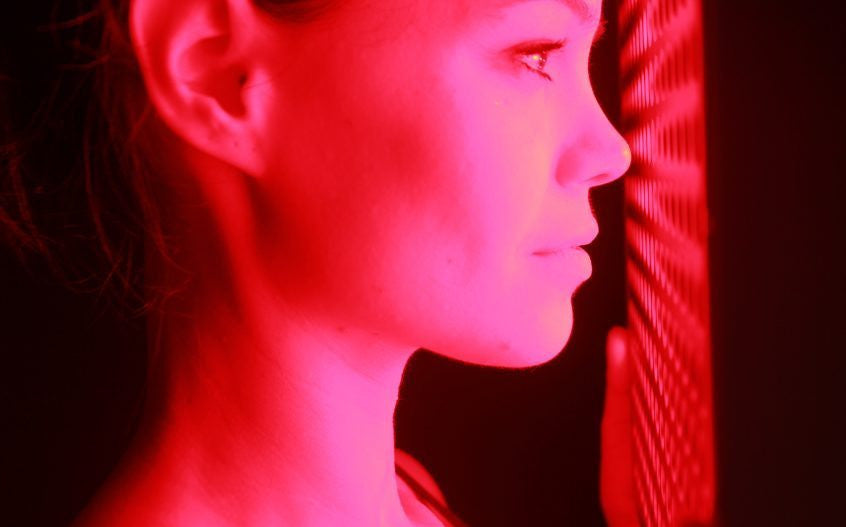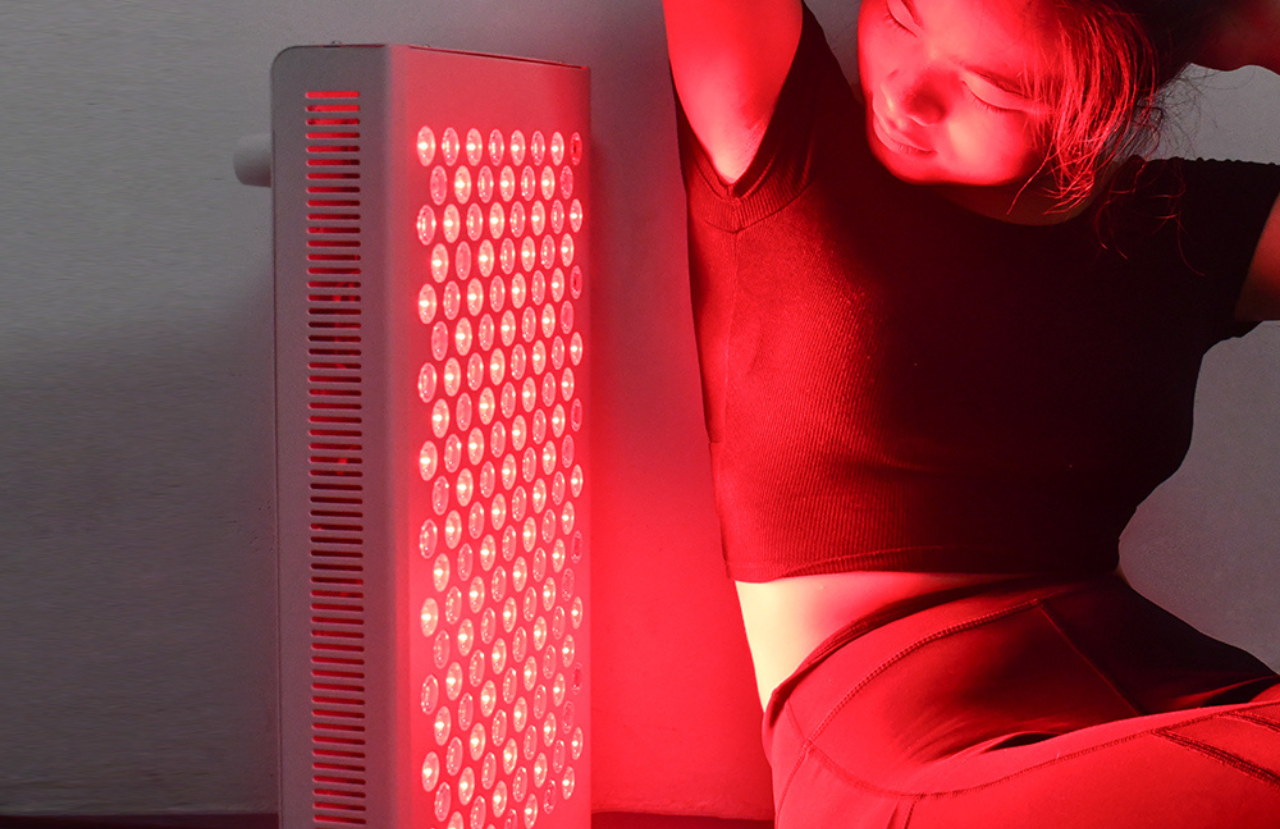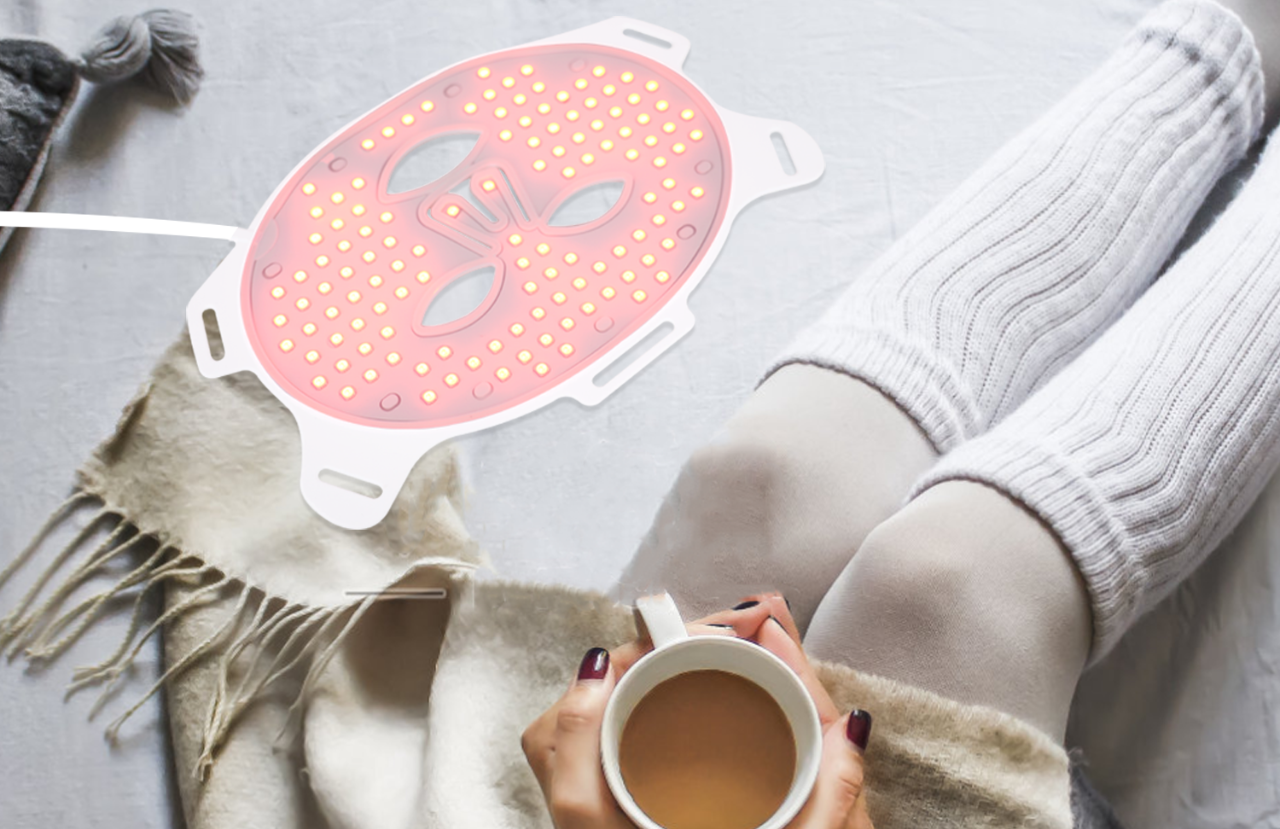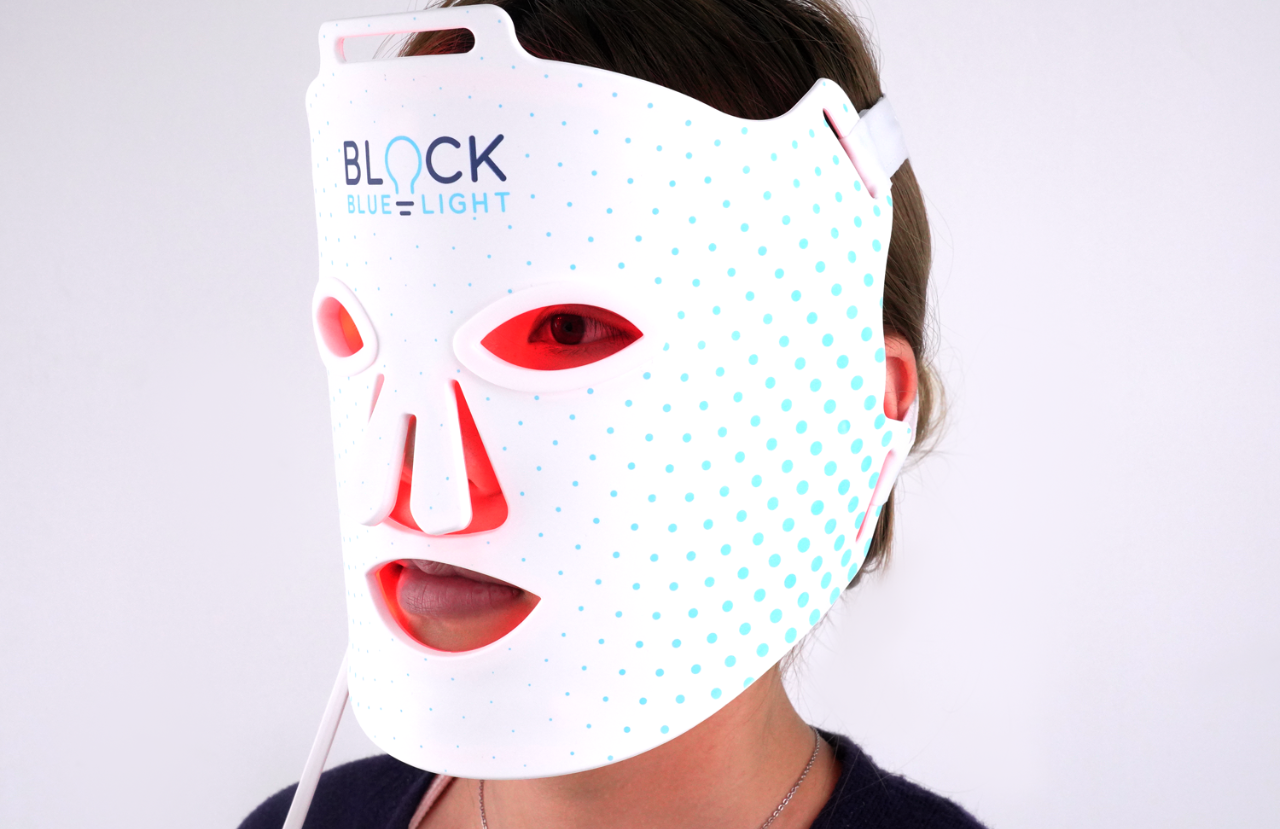If you are experiencing skin issues then Red Light Therapy could be for you.
Red Light Therapy boasts endless benefits for the skin. But getting regular treatments can end up being expensive.
If you’re interested in learning the benefits of Red Light Therapy, and how to do it at home.
Here is our guide which helps you to get the skin benefits of Red Light Therapy whilst keeping long-term costs down.
Does Red Light Therapy Improve Skin?
Clinical research shows that Red Light Therapy significantly improves collagen production, fine lines, wrinkles, skin complexion, skin tone, and smoothness.¹
The findings of the LED light therapy study found that three weekly sessions for a year significantly improved unwanted skin issues that are common from sun damage and premature aging.
It was noted that Red LED Light Therapy can be effectively used for facial and body skin rejuvenation and restoration.
Participants reported satisfaction with the results, and improved skin health, complexion and feeling.
The research shows that Red LED Light Therapy is a great way to get results. However, going to a local spa to receive treatment can end up being costly.
Investing in a Red Light Therapy Panel is a great way to keep long-term costs down.
In comparison - the money you invest results in a product that you own for a lifetime.
You can enjoy as many sessions as you wish. And share the therapeutic benefits with friends and family!
Rather than going to a spa, it makes financial sense to invest in a panel for the lifetime benefits of LED Light Therapy, and flexibility in use.
Is Red Light Therapy At Home Effective?
Infrared Light Therapy at home is just as effective as going to a salon or spa which has a Red Light Therapy Panel.
The beauty of LED Light Therapy is that it is a non-invasive skin procedure. This means the treatment is painless and super easy to do at home.
If you want to learn more about the science of how Red and Infrared Light Therapy works on the skin, you can check out our blog post on The Incredible Benefits Of Red & Infrared Light Therapy here.
The benefit of doing your LED Light Therapy at home is that you’re able to easily fit the treatment into your own schedule without having to go anywhere or make an appointment. And you can set your own environment.

You don’t have to pay for timed sessions, and can use the Red Light Therapy PowerPanel as much or as little as you want without potentially wasting money from an unused booked session or minutes.
You can create your own home spa ritual with your LED Light Therapy. Put on some aromatherapy and a spa playlist. And enjoy Red Light Therapy in the comfort of your own home.
There is no downtime needed for Red Light Therapy - which means it won’t interrupt your day, or make your skin red or blotchy.
You can do your session, and go to work or see your friends immediately - without them knowing your youthful secret!
Home Red Light Therapy Benefits:
- Invest your money into a product for lifetime independent use
- Flexibility around using times and session lengths
- Home use (no travel times or extra travel expenses)
- Personal tailoring of environment and comfort
- No limit on the number of people that can use the Red Light Therapy PowerPanel (financial savings)
How To Use Red Light Therapy At Home On Your Face
It’s super simple to use a Red Light Therapy Device at home because the treatment is non-invasive.
Tips For Using Red Light Therapy At Home
- Take before pictures so that you can observe the results as your skin improves over time.
- Make a schedule or pick a suitable time for your therapy so that you don’t forget to do it.
- Pamper yourself with some candles, spa music, and aromatherapy.
- LED lights don’t contain UVA or UVB rays, but it is still a good recommendation to protect your eyes with protective eyewear when using your Red Light Therapy Device.
- Try a 10-20 minute session 3 times a week, and move up to 5 sessions a week if you have time.
- Sit somewhere comfortable where you can relax whilst you enjoy your LED Light Therapy.
How Often Should You Use Red Light Therapy On Your Face?

One clinical study found that using your Red Light Therapy Device three times a week for a duration of 20-minutes can show results in as little as three weeks.²
The more you use your LED Light Therapy Panel, the quicker you will see results.
Start with three a week, and more up to five times a week if your schedule allows.
The most important part is to be consistent to see results. So you really want to ensure you are doing your Red Light Therapy at three twice a week, every week.
Benefits Of Red Light Therapy
Clinical research by Dermatologists found that Red Light Therapy has multiple beneficial uses.²
Dermatologists note that Red Light Therapy is a safe treatment for a variety of medical and aesthetic skin issues and conditions that are usually problematic and hard to treat.
They found that the average lesion count was reduced by 46% four weeks post-treatment. And by 81% at 12 weeks post-treatment. The wound healing and inflammation results found that the skin healed twice as quickly when an LED light therapy device was used.
Red Light Therapy is now widely used in medical and cosmetic cases.
A light therapy device can be effective pain relief for inflamed and irritated skin problems.
A Red Light Device Is Good For
- Reducing fine lines and wrinkles
- Smoothing skin roughness
- Increasing collagen production
- Healing acne
- Speeding wound healing
- Treating actinic keratosis (from sun exposure and sun damage)
- Reducing rosacea
- Treating skin mites
- Reducing skin inflammation
How Does Red Light Therapy Work On The Skin?
There are different wavelengths of light that can be separated into those we can see, and those we can’t.
UVA and UVB rays and infrared light wavelengths are invisible to the human eye. Whereas light wavelengths visible to the human eye are found in all different colors.
There are different wavelengths of light on the visible light spectrum. The wavelengths penetrate the skin (dermis) to different depths and correspond to different colors of LED light.
The red light wavelength found in red light LED therapy penetrates the skin (dermis) and works on fibroblasts, and improves cellular function. Fibroblasts are cells that are found in connective tissue.
If you’re looking to keep your skin rejuvenated, healthy, and radiant - then taking care of fibroblast cells is important!
Fibroblasts contribute to wound healing, but they also produce collagen proteins.
Collagen protein is vital for skin elasticity and makes up for three-quarters of your skin’s structure.

When red light penetrates into the dermis it is able to stimulate the healthy function and production of collagen proteins, essential proteins, and elastin.
The light is absorbed, converted into energy, and used to stimulate elastin, collagen, and adenosine triphosphate (ATP) which creates energy for healthy cell function and repair.
Red light increases oxygenation and improves blood circulation which helps to smooth skin texture.
Light therapy treatment has a wide variety of benefits such as improving joint pain, due to its effect on stimulating blood flow and fibroblast function.
Red light therapy treatment includes both red light wavelengths and infrared wavelengths. Whilst this article is mainly about red light wavelengths, infrared wavelengths have their own individual benefits too.
Clinical research on infrared light therapy shows that collagen, elastin, and fibroblasts are also increased by infrared light therapy. Patients reported a 25-75% improvement in skin texture and skin tone.³
Much like red light therapy, infrared light therapy has its own unique applications due to working specifically deep into muscle tissues and nerves. Infrared therapy is particularly useful for speeding recovery, pain relief, and reducing inflammation.
Conclusion
The clinical results support both medical and aesthetic benefits to Red Light Therapy treatment. This is a beautiful non-invasive way to treat a multitude of skin problems and skin inflammation.
If you wish to start your journey to healthy and glowing skin - you can invest in your very own Red Light Therapy Device here.
The BlockBlueLight Red Light Therapy PowerPanel comes in several different sizes to suit your treatment area needs. And we also stock a portable travel option so you don’t have to miss an LED light treatment when you will be on the road.
Our Red Light Therapy PowerPanels are flicker-free and come equipped with adjustable automatic timing settings.

You'll also find our panels come with a stand. Which ensures you can sit comfortably for even coverage and treatment of the desired area.
There are also optimized with the most effective and research wavelengths to ensure you see the best results!
Begin your journey to fresh and rejuvenated skin today!
Sources:
- https://www.ncbi.nlm.nih.gov/pmc/articles/PMC3926176/
- https://www.ncbi.nlm.nih.gov/pmc/articles/PMC5843358/
- https://www.ncbi.nlm.nih.gov/pmc/articles/PMC2687728/
- https://onlinelibrary.wiley.com/doi/full/10.1111/php.12864
- https://www.ncbi.nlm.nih.gov/pmc/articles/PMC4148276/
- https://pubmed.ncbi.nlm.nih.gov/28748217/
- https://www.ncbi.nlm.nih.gov/pmc/articles/PMC6250649/
- https://www.ncbi.nlm.nih.gov/pmc/articles/PMC4126803/
- https://www.ncbi.nlm.nih.gov/pmc/articles/PMC4126803/
- https://www.ncbi.nlm.nih.gov/pmc/articles/PMC3926176/
- https://www.ncbi.nlm.nih.gov/pmc/articles/PMC4126803/
- https://www.ncbi.nlm.nih.gov/pmc/articles/PMC4126803/
- https://pubmed.ncbi.nlm.nih.gov/19698001/
- https://pubmed.ncbi.nlm.nih.gov/15145195/
- https://pubmed.ncbi.nlm.nih.gov/28223291/
- https://pubmed.ncbi.nlm.nih.gov/21740089/
- https://pubmed.ncbi.nlm.nih.gov/23355338
- https://pubmed.ncbi.nlm.nih.gov/20393809/
- https://pubmed.ncbi.nlm.nih.gov/29185134/
- https://pubmed.ncbi.nlm.nih.gov/16875447/
- https://pubmed.ncbi.nlm.nih.gov/21739259/
- https://pubmed.ncbi.nlm.nih.gov/29385005/
- https://pubmed.ncbi.nlm.nih.gov/24258312/
- https://pubmed.ncbi.nlm.nih.gov/27027049/
- https://pubmed.ncbi.nlm.nih.gov/27913970/
- https://pubmed.ncbi.nlm.nih.gov/23093133
- https://pubmed.ncbi.nlm.nih.gov/25239030
- https://onlinelibrary.wiley.com/doi/abs/10.1002/jbio.201800120






